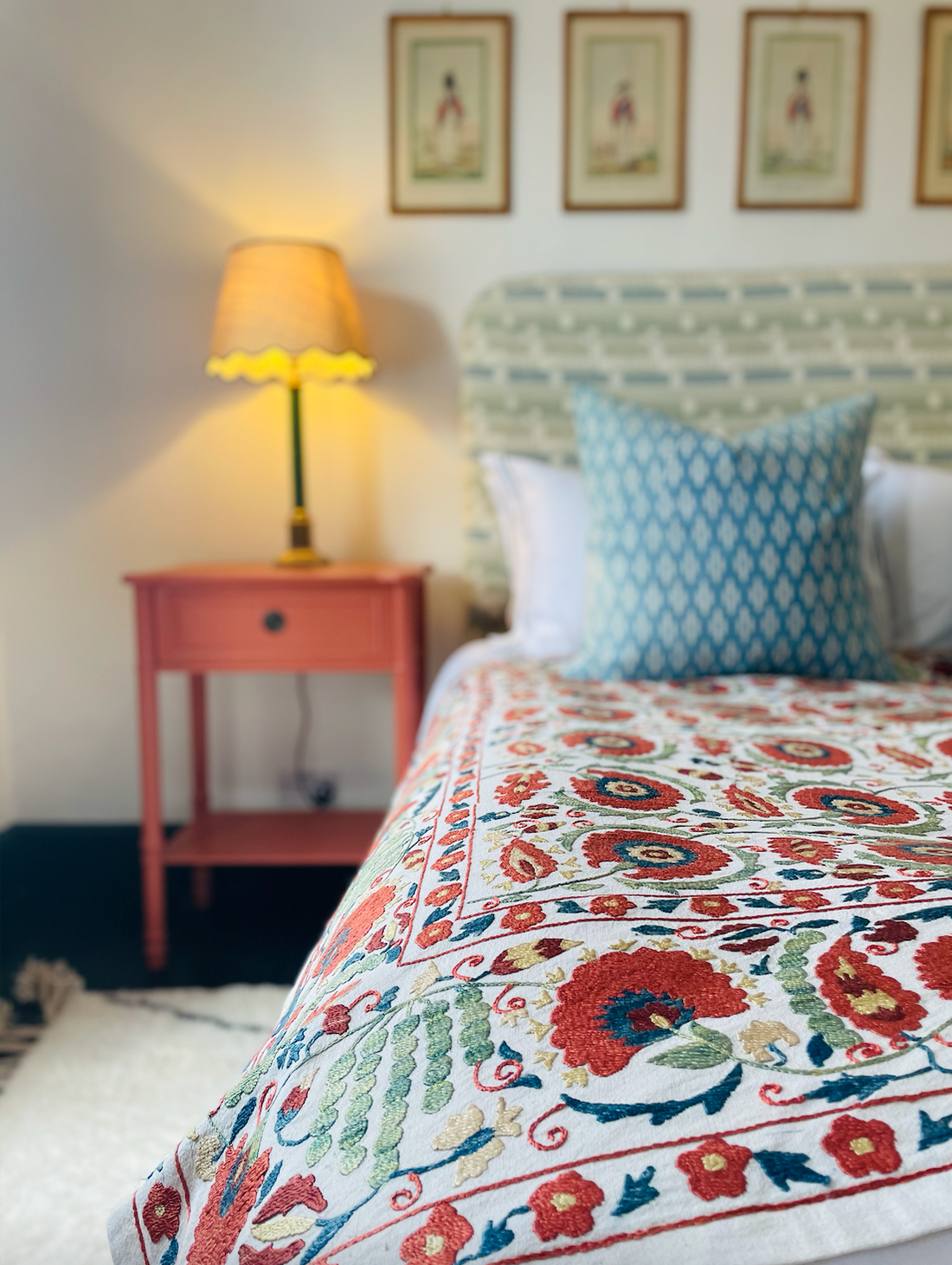Welcome to the colourful world of suzani fabric. If you haven't heard of these glorious fabrics before - don't panic, I'm something of an expert/superfan, and I'm here to share some interesting facts - and most importantly - how to stylishly incorporate them into your home.

The History Of Suzanis
First up, the term suzani comes from the Persian word, suzan, which simply means 'needle'. Made in many Central Asian countries including Takikistand, Uzbekistan and Kazakhstan, a suzani is a type of intricate textile, hand embroidered with a needle to create a beautiful one-off piece.
Originally used for lining yurts - a type of nomadic tent - or for protecting ground-level beds and sitting on, the oldest examples of suzani textiles date back to the late eighteenth and early nineteenth century.
Suzanis were often given as part of a dowry, hand embroidered by the bride and her mother and gifted to the groom on the wedding day. Adorned with symbols of luck, fertility and health, the suzani represented the coming together of two families.
Makers used a wealth of different techniques to tell the story on the fabric; chain, satin and buttonhole stitches were lovingly hand-crafted onto cotton or occasionally silk pieces. The pattern was often hand drawn onto the fabric first with multiple pieces joined together to form one larger suzani; this allowed for more than one person to work on it at any one time. Pen marks can often still be seen - which should not be considered a fault but rather part of the story of the piece. Similarly, the join where fabrics have been sewn together is often perfect in its imperfection. I like to imagine how two pieces came together.

Styles and symbols
Predominantly made of cotton - but occasionally silk - a suzani textile would have been hand embroidered with cotton or silk threads in bold and beautiful designs which were symbolic and distinctive to the region in which it was made. There are often flowers, leaves, vines and fruits along with sun and moon designs.
In Uzbekistan alone, the signature styles from region to region are evident: Puskent suzanis often feature crimson star motifs, while Nurata textiles showcase more naturalistic flowers. Bukhara suzanis are made up of red toned flowers and serrated leaves on vines. A piece from Tashkent is likely to have large medallions arranged in rows with serrated borders.

How to style your suzani
While a suzani looks perfectly at home lining the chicest of yurts, it can also look perfect in your home and is a fantastic way to inject some pattern, colour and texture to a scheme. Thankfully there are many options to consider to suit your space; first up, ask yourself if your piece is to be displayed or used in a more functional capacity?
With verified, antique pieces dating from the nineteenth century reaching prices of £5000 and upwards, you may prefer to keep your treasure displayed as a suzani wall hanging and avoid sticky little fingers all over it! For this option you can use a dowel rod or even a curtain rail with hooks or clips and it may be worth having the textile lined to give it extra weight which will allow it to hang flatter. There are some great options for hanging textiles at Architectural Digest and why not take a look at this spectacular vintage suzani from Christies which went for over double its suggested sale price!
For particularly precious pieces you may wish to frame the textile behind glass or acrylic, this does, however, remove the lovely exposed stitching which I love and is definitely part of the charm.

A firm favourite amongst interior designers and influencers - myself included - is to drape your suzani over a sofa or a bed. Choosing a particularly colourful suzani will allow a magnitude of styling options. Pull in similar tones across the cushions and mix and match textures for an elegant layered look. I like to combine multiple textures in a room including silk sari lampshades, ceramic lamp bases, vintage cotton and silk suzanis mixed with velvet and kilim cushions. This combination provides a stunning visual and textural delight.
Newer, modern suzanis which are generally made in India are often more simple in their designs and palette, often using just two or three colour threads. These can be more affordable than vintage pieces and can look fabulous when stretched over a canvas so the design can be seen clearly. If you opt to have a suzani stretched it can be much more cost effective than framing.
Whatever way you choose to style your suzani you're bringing a piece of history into your home, celebrating heritage, craftsmanship and a one of a kind piece to be cherished. I take great pride in the collection of suzani fabrics I collated for Sourced by Holly and I'm always happy to answer questions and offer advice on how to live with and love these timeless treasures.
To shop the collection of suzani textiles for sale visit sourcedbyholly.co.uk/suzani-fabrics
Love Holly x


